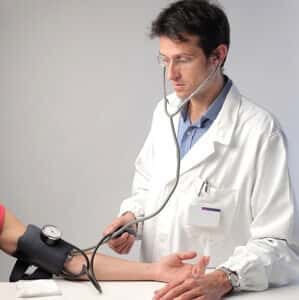
Every one knows the dangers of hypertension. We are repeatedly told that the “silent killer” leads to heart attacks, strokes, kidney disease, blindness and dementia, to name just some of the scary consequences of uncontrolled high blood pressure. The problem is that the bar keeps changing. During the mid 20th century a leading cardiologist, Charles Friedberg, MD, wrote that blood pressure up to 210/100 did not require drug treatment (Journal of Clinical Hypertension, Suppl. 8, Aug. 2006). Most everyone now agrees that was way too lax. Guidelines in 2003 recommended blood pressure treatment when levels reached 140/90.
The New Blood Pressure Treatment Guidelines:
Experts for the American Heart Association (AHA) and the American College of Cardiology (ACC) have created new guidelines for aggressive blood pressure treatment. All adults are supposed to get systolic blood pressure to 130 or lower. Diastolic blood pressure readings are supposed to be 80 or below (Circulation, Nov. 13, 2017).
What does that mean in practical terms? For starters, these guidelines mean that roughly half of all adults in America (100 million people) are now labeled hypertensive. Being diagnosed with a condition like hypertension will make some people anxious (Hypertension, Sept. 2010). Many health professionals believe that is a small price to pay for effective treatment.
Side Effects of Aggressive Blood Pressure Treatment:
What we are not told by the experts is that aggressive blood pressure treatment with medications may also pose risks. A study in JAMA Internal Medicine (online, Feb. 24, 2014) found that older people treated with moderate to high-dose antihypertensive medications were at 30 to 40 percent increased risk of dangerous falls.
Nearly 5,000 Medicare beneficiaries were tracked for three years. Most (86 percent) were taking at least one drug for high blood pressure. Nearly one third were taking two or three different kinds blood pressure pills simultaneously. Older people who fell experienced joint dislocations, hip fractures and major head injuries. In many cases these accidents led to disability or even death.
One reader shared her own experience:
“I am taking amlodipine (Norvasc), carvedilol (Coreg) and losartan (Cozaar) for high blood pressure. These drugs have me feeling bad. Last September I fell and completely passed out. I had a broken pelvis, broken rib and a concussion. I was hospitalized and had to spend two months in rehab. If this happens again it is curtains for me.”
A fall like this is a red flag for another accident. The researchers found that the risk for a second serious fall more than doubles in patients taking multiple blood pressure medications.
Beware Misdiagnosis and Unnecessary Treatment:
We are constantly surprised at how casually some health professionals diagnose hypertension. And now, with the target so low, a lot of people will receive aggressive blood pressure treatment that may be unnecessary. Here is one example:
M.M.V. was taking a decongestant that raised blood pressure:
Balancing Benefits and Risks:
Balancing the benefits of blood pressure medicine against their risks is a delicate proposition. Many people are confused about the guidelines. Should they request aggressive blood pressure treatment to get their numbers below the magical 130/80 target?
As long as side effects such as dizziness, drowsiness, brain fog or unsteadiness are not a problem, the benefits of aggressive blood pressure treatment may well outweigh the risks. When people find that their quality of life is affected by their medicine, however, they may need to discuss their treatment program with the prescribing physician.
Only a few years ago, experts were relaxing their recommendations. Instead of aiming for 140/90 in those over 60, experts determined that physicians should only treat hypertension when the upper number (systolic blood pressure) exceeds 150 (JAMA, Feb. 5, 2014).
That is very different from today’s guidelines. We encourage readers to work closely with their primary care provider to find a middle ground that minimizes side effects from drug treatment.
Aggressive Blood Pressure Treatment with Beta Blockers:
Another reader shared this experience with a beta blocker blood pressure drug:
“I have been on metoprolol for years and before that it was Toprol. I have asked numerous doctors why I have experienced so many symptoms. I’ve had fatigue, depression, palpitations, dizziness, difficulty breathing, coughing, cold feet and hands, light headedness, poor coordination, and many other problems. I have asked a number of doctors to change my blood pressure medicine but they all seem to just laugh it off. Am I wrong in wanting to change?”
Beta blockers like atenolol, metoprolol and propranolol can cause such symptoms. The new blood pressure guidelines specifically reserve beta blockers for the last line of therapy, only after other approaches have failed. Never stop such drugs suddenly, though, as doing so can trigger chest pain, irregular heart rhythms or even a heart attack.
Share Your Story:
How do you control your blood pressure? Share your story in the comment section below. We would like to know if nondrug approaches have ever worked for you. If you would like to read about a variety of strategies, you may find our Guide to Blood Pressure Treatment of interest.

